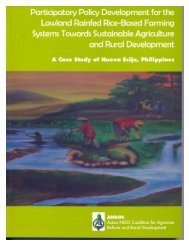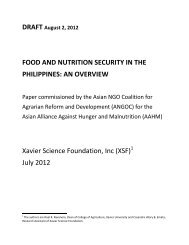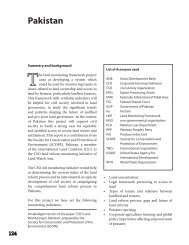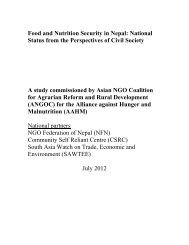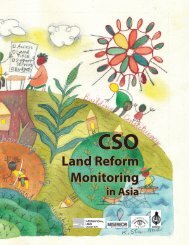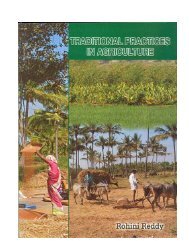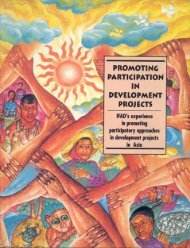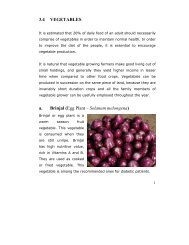Securing the Right to Land FULL - ANGOC
Securing the Right to Land FULL - ANGOC
Securing the Right to Land FULL - ANGOC
Create successful ePaper yourself
Turn your PDF publications into a flip-book with our unique Google optimized e-Paper software.
SECURING THE RIGHT TO LAND<br />
84<br />
In 1960, <strong>the</strong> Debhar Commission, pursuant <strong>to</strong> Article 339 of<br />
<strong>the</strong> Constitution, recommended that all tribal land alienated<br />
since 26 January 1950—<strong>the</strong> day <strong>the</strong> Constitution came in<strong>to</strong><br />
force—be returned <strong>to</strong> <strong>the</strong>ir original tribal owners.<br />
The Provisions of <strong>the</strong> Panchayats (Extension <strong>to</strong> <strong>the</strong> Scheduled<br />
Areas) Act (PESA) of 1996 came in<strong>to</strong> force on 24 December<br />
1996. It gives wide ranging powers <strong>to</strong> <strong>the</strong> Gram Sabha, or village<br />
assembly, for taking decisions on: (1) land acquisition within<br />
scheduled areas; (2) granting mining leases (for minor minerals);<br />
and (3) ownership of minor forest produce, etc. Section 4 (i) of<br />
PESA clearly states that <strong>the</strong> Gram Sabha shall be consulted before<br />
making <strong>the</strong> acquisition of land in <strong>the</strong> scheduled areas for<br />
development projects and before resettling or rehabilitating persons<br />
affected by such projects in <strong>the</strong> scheduled areas.<br />
In <strong>the</strong> landmark Samatha judgment, in 1997, <strong>the</strong> Supreme<br />
Court fur<strong>the</strong>r interpreted <strong>the</strong> Fifth and Sixth Schedules of <strong>the</strong><br />
Indian Constitution as intending not only <strong>to</strong> prohibit acquisition<br />
and alienation of land in tribal areas by non-tribals, but <strong>to</strong><br />
ensure that <strong>the</strong> tribals remain in possession and enjoyment of<br />
lands in scheduled areas for <strong>the</strong>ir economic empowerment,<br />
social status, and dignity of <strong>the</strong>ir person.<br />
Policy on Women’s <strong>Land</strong> <strong>Right</strong>s<br />
<strong>Land</strong> reform laws have not adequately addressed <strong>the</strong> issue of<br />
unequal ownership of land between men and women. The <strong>Land</strong><br />
Ceiling Act classifies <strong>the</strong> family unit as comprising husband, wife<br />
and three minor children. While adult sons are considered separate<br />
units, unmarried adult daughters are left out. Even <strong>the</strong> Tenancy<br />
Act gives priority <strong>to</strong> males (from <strong>the</strong> fa<strong>the</strong>r’s side) in inheritance<br />
and <strong>to</strong> widows only in <strong>the</strong> absence of male heirs. However, now<br />
<strong>the</strong> Hindu Succession (Amendment) Act of 2005 has been enacted<br />
<strong>to</strong> remove gender discrimina<strong>to</strong>ry provisions in <strong>the</strong> Hindu<br />
Succession Act of 1956, and make <strong>the</strong> daughter a coparcener<br />
in her own right by birth in <strong>the</strong> same manner as <strong>the</strong> son.<br />
Fac<strong>to</strong>rs Facilitating or Impeding<br />
Access <strong>to</strong> <strong>Land</strong> and Tenurial Security<br />
Government<br />
While land reforms are under <strong>the</strong> jurisdiction of <strong>the</strong> States, <strong>the</strong><br />
Central Government has taken <strong>the</strong> following measures <strong>to</strong> promote<br />
land reforms:<br />
Directed State governments <strong>to</strong> enact agricultural land ceiling<br />
laws, and <strong>to</strong> redistribute ceiling–surplus land among<br />
landless and marginal farmers;<br />
Amended <strong>the</strong> Constitution 13 times <strong>to</strong> remove legal obstacles<br />
<strong>to</strong> land reforms;<br />
Formulated Five–Year Plans (through <strong>the</strong> National Planning<br />
Commission) which consistently emphasized land reforms<br />
and incorporated policy guidelines in this regard. The current<br />
Eleventh Five–Year Plan (2007–2012) has also incorporated<br />
<strong>the</strong> component of land reforms in all its dimensions.<br />
Ministry of Rural Development—Department of <strong>Land</strong> Resources<br />
as <strong>the</strong> nodal agency in <strong>the</strong> Central Government has<br />
since been active in promoting land reforms in various ways.<br />
Political Parties<br />
India has a multi-party system with <strong>the</strong> two largest parties alter-<br />
natively leading coalition governments at <strong>the</strong> Center: The Indian<br />
National Congress (INC) and <strong>the</strong> Bharatiya Janata Party (BJP). The<br />
INC-led alliance is called <strong>the</strong> United Progressive Alliance (UPA),<br />
while <strong>the</strong> BJP-led alliance is called <strong>the</strong> National Democratic Alliance<br />
(NDA). The two formations—despite pulls and pressures from<br />
<strong>the</strong> alliance partners who have <strong>the</strong>ir own power centers in <strong>the</strong><br />
States—have been generally stable. The third emerging alliance is<br />
<strong>the</strong> United National Progressive Alliance (UNPA), which would<br />
form a non-INC, non-BJP “third front.”<br />
The parties have articulated <strong>the</strong>ir position on land reforms in<br />
detail as follows.<br />
Bharatiya Janata Party (BJP)<br />
The BJP 8 is regarded as rightist, but would ra<strong>the</strong>r be characterized<br />
as nationalist. The NDA, a coalition of which <strong>the</strong> BJP is <strong>the</strong><br />
major partner, has carefully avoided <strong>the</strong> issue of land distribution<br />
through land reforms since it was formed in 1998.






